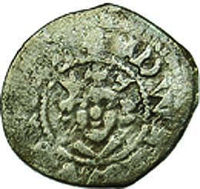020 7636 1188 info [at] coincraft.com
You have no items in your shopping cart.
English Hammered Coins
View as
Sort by
Display per page
Filter by attributes
- Pre-Decimal Denomination
- Penny
- Shilling (Bob)
- Currently shopping by:
- Pre-Decimal Denomination: Farthing or Sixpence (Tanner) or Crown
- Monarch: Edward I 1272 - 1307 or Elizabeth I 1558 - 1603
Edward I, Farthing Fine
The farthing marked the start of a revolutionary coinage reform by Edward I. Until this time, the penny was the smallest denomination. Low value transactions could be conducted using pennies cut into halves or quarters. The act of cutting pennies into quarters or fourths was how the word Farthing or “fourthing” came about. These silver farthings were introduced by Edward I during the recoinage of 1279. They brought about the end of the practice of cutting coins into halves and quarters. The old coinage and the use of pennies cut into farthings remained legal tender until they were demonitised in August 1280. These coins were the smallest silver coins of the early medieval period and were well circulated and are now over 700 years old, and they are much scarcer than the Pennies. We have been putting these aside for many years and are delighted to offer them to you now, for the first time. Available in Fine, while stocks last.
£99.50
Elizabeth I, Sixpence (Ewerby Hoard)
In 2016 a hoard of English silver coins, buried during the Civil War (1642-1651) was discovered in Ewerby, Lincolnshire. They were declared and are thus legal for you to own. They were put up for auction and we bought all the Elizabeth I Silver Sixpences at the auction. It is normal to find earlier coins in a hoard from the date it was buried, as they were buried to protect the hoard and the owner. We bought the Sixpences because that is one coin of Elizabeth I that has a date on it. Elizabeth I Silver Sixpences are dated between 1560 and 1602 and while having seen a lot of circulation they are struck in good silver. Don’t forget these coins are between 420-460 years old and are real British Treasure. The sixpence is great because it has a date on it and is also great for weddings, where the bride should carry a sixpence in her shoe. Something old, something new, something borrowed, something blue, and a sixpence in your shoe. In the days of Elizabeth I, you could get by for about a week if you had a sixpence. It was real money at the time. We offer these coins in five different grades. Each coin comes with a certificate of authenticity. Supplies are limited.
From £69.50
Elizabeth I, Sixpence (Ewerby Hoard) Poor
Coins are occasionally clipped. The obverse portrait will be worn out but legends are readable. The reverse will usually have a clear impression of the shield and date.
£69.50




























